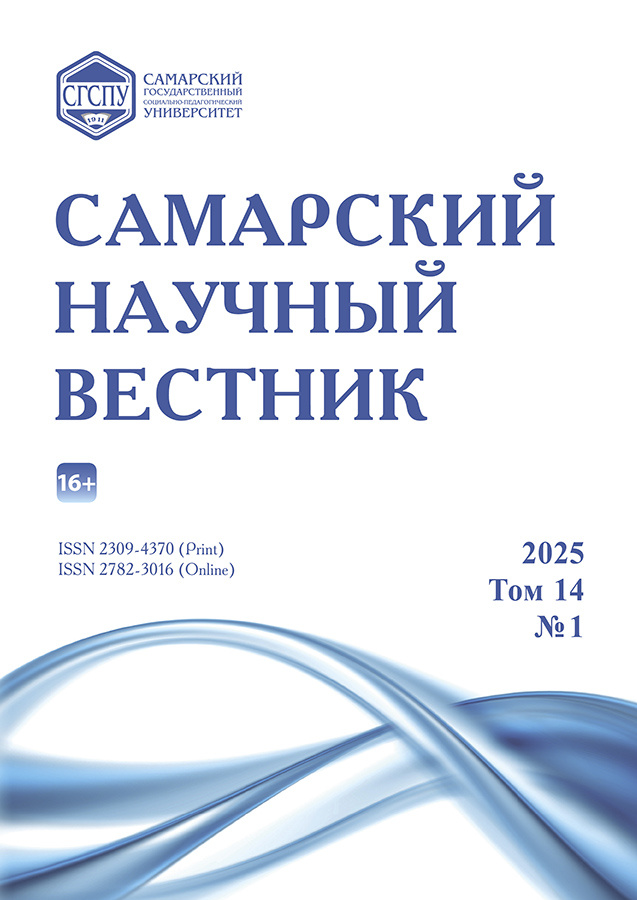The use of animation in the interpretation of fiction and mathematical text in elementary school
- Authors: Grakhova S.I.1, Belyaeva N.L.1, Yarulina T.I.1
-
Affiliations:
- Naberezhnye Chelny State Pedagogical University
- Issue: Vol 14, No 1 (2025)
- Pages: 122-127
- Section: Pedagogical Sciences
- URL: https://bakhtiniada.ru/2309-4370/article/view/313676
- DOI: https://doi.org/10.55355/snv2025141303
- ID: 313676
Cite item
Full Text
Abstract
The authors of the article introduce readers to the technology of developing educational animation and its application in the interpretation of artistic and mathematical texts in elementary school. The paper suggests algorithms of actions for the development of visualization, focusing on the text, its details, and the image system in the process of interpretive activity using animation. Examples of technology for developing visual representations of abstract mathematical concepts and relationships using animation are given; creating animations to represent the concepts of «number», «addition of single digits» and others. In interpreting a literary text, animation helps to visualize images and events, to focus on important details, to create an emotional mood and to develop creative imagination. In interpreting a mathematical text, it is important to visualize abstract mathematical concepts and relationships, visualize the process of solving problems, create problematic situations, and develop an interest in mathematics. The use of animation as an interpretive activity tool depends on the style, genre, type, content of the text, the target audience, and the planned learning outcome. The article presents step-by-step steps for self-design and development of animation videos for working on text interpretation, formulates practical recommendations for integrating animation into the learning process, including steps of working with animation, examples of tasks and forms of use. The authors note that the integration of animation into the educational process is implemented on the principle of «from simple to complex» and is implemented both by watching ready-made videos and by creating author's products using digital tools (programs, services, designers) and, last but not least, taking into account the basic principle: animation materials should illustrate the text, not to replace it, and to be understandable to elementary school students.
Full Text
##article.viewOnOriginalSite##About the authors
Svetlana Ivanovna Grakhova
Naberezhnye Chelny State Pedagogical University
Author for correspondence.
Email: sg2223@yandex.ru
candidate of philological sciences, associate professor of Theory and Methodology of Primary and Preschool Education Department
Russian Federation, Naberezhnye Chelny, Republic of TatarstanNina Leonidovna Belyaeva
Naberezhnye Chelny State Pedagogical University
Email: belyaevanl@yandex.ru
candidate of pedagogical sciences, associate professor of Theory and Methodology of Primary and Preschool Education Department
Russian Federation, Naberezhnye Chelny, Republic of TatarstanTansylu Ilhamovna Yarulina
Naberezhnye Chelny State Pedagogical University
Email: tata_sun17@mail.ru
master student of Theory and Methodology of Primary and Preschool Education Department
Russian Federation, Naberezhnye Chelny, Republic of TatarstanReferences
- Грахова С.И. Цифровые технологии в практике интерпретации текста в школе // Проблемы современного педагогического образования. 2023. № 78–1. С. 107–110.
- Грахова С.И., Ярулина Т.И. GIF-анимация как средство обучения младших школьников интерпретации художественного произведения // Наука и технологии: междисциплинарные исследования: сб. науч. работ XVII междунар. науч.-практ. конф. Мельбурн, 2024. С. 165–174.
- Выготский Л.С. Лекции по психологии. Мышление и речь. М.: Юрайт, 2024. 432 с.
- Выготский Л.С. Психология развития. Избранные работы. М.: Юрайт, 2024. 281 с.
- Эльконин Д.Б., Давыдов В.В., Цукерман Г.А. Как учить детей. М.: Знание, 1991. 80 с.
- Светловская Н.Н., Пиче-оол Т.С. Методика обучения творческому чтению: учеб. пособие. М.: Юрайт, 2024. 305 с.
- Бунеева Е.В., Чиндилова О.В. Технология продуктивного чтения: её сущность и особенности использования в образовании детей дошкольного и школьного возраста. М.: Баласс, 2014. 43 с.
- Джежелей О.В. Развитие речи и обучение чтению: метод. пособие. М.: Валент, 1994. 71 с.
- Уколова Т.В. Формирование готовности школьников к культурологической интерпретации в обучении гуманитарным предметам // Искусство и образование. 2009. № 6. С. 129–134.
- Андреев А.А. Педагогика высшей школы. Новый курс. М.: Московский международный институт эконометрики, информатики, финансов и права, 2002. 264 с.
- Роберт И.В. Теория и методика информатизации образования (психолого-педагогический и технологический аспекты). М.: Бином. Лаборатория знаний, 2014. 398 с.
- Полат Е.С., Бухаркина М.Ю., Моисеева М.В., Петров А.Е. Новые педагогические и информационные технологии в системе образования: учеб. пособие / под ред. Е.С. Полат. М.: Академия, 2002. 272 с.
- Кузнецов А.А., Агафонова К.Е., Юсупова К.Т. Цифровые технологии в педагогической деятельности: учеб. пособие. М.: Инфра-М, 2025. 223 с.
- Никандров Н.Д. Перспективы развития образования в России. СПб.: СПбГУП, 2005. 24 с.
- Беспалько В.П., Татур Ю.Г. Системно-методическое обеспечение учебно-познавательного процесса подготовки специалистов. М.: Высшая школа, 1989. 144 с.
- Башмаков М.И., Поздняков С.Н., Резник Н.А. Информационная среда обучения. СПб.: Свет, 1997. 400 с.
- Уваров А.Ю., Гейбл Э., Дворецкая И.В. Трудности и перспективы цифровой трансформации образования / под ред. А.Ю. Уварова, И.Д. Фрумина. М.: Издательский дом Высшей школы экономики, 2019. 342 с.
- Панюкова С.В. Использование информационных и коммуникационных технологий в образовании: учеб. пособие. М.: Академия, 2010. 221 с.
- Лаптев В.В. Инфографика в цифровом искусстве: учеб. пособие / ред. В.М. Иванов. М.: Аватар, 2015. 286 с.
- Лапчик М.П. Подготовка педагогических кадров в условиях информатизации образования: учеб. пособие. М.: Бином. Лаб. знаний, 2013. 182 с.
Supplementary files






